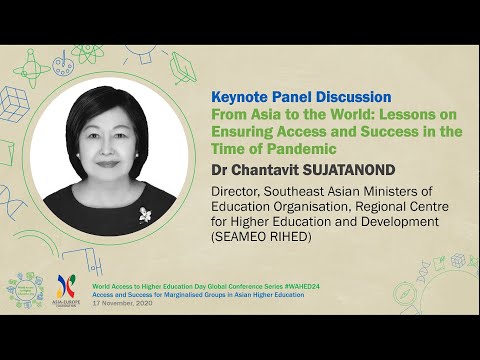WAHED 2020 Asia Conference | Opening Keynote by Dr Chantavit SUJATANOND

our next speaker is a friend of the asia europe foundation for quite some time uh her name is dr chanthavit sutchatanand and she comes from the semi rehab organization where she is the director her organization has an incredibly long name so let me however emphasize it it's the southeast asian ministers of education organization the regional center for higher education and development as i said in short similar we had thank you chandavi for being with us today chandavit has been earlier deputy director for administration and communication at the senior secretariat from 2004 and 2007. she has also worked as deputy secretary secretary general for the office of the higher education commission ohek in thailand um and yeah you have almost two decades of service in ohac so you are really an expert of regional cooperation in this context we have also worked with chanternet before your background is in fact in linguistics and you have a phd in education administration very happy to have you here with us chanthanit uh you have about 10 minutes for your presentation and you will share from a regional perspective how we can support access and success for marginalized students and learners here in asia in south east asia in particular thank you the floor is your standard thank you very much leonie good morning friends and colleagues and distinguished speakers for this particular conference and i must congratulate essec for organizing such a great events of world access to higher education the global conference today and i hope that there will be more in the series to come can you move on to my first slide please next please next slide please thank you so this is the organization that leonie was mentioning that the name is very long actually it's a regional international organization responsible for education science and culture and it has extended arms called regional centers we have 26 centers around the region in different countries member countries of southeast asia next please about us about simula we had we have been established since 1959 and become to become part of signio in 1993 up until present days so we continue our work to advance cooperation alignment and development of higher education system in the region by creating policy platforms where national leader of higher education meets regularly twice a year and also engaging in policy driven research and also broadening space for information dissemination next please we also share our and forms with the seven priority areas of simeon which is on the right side of your slide and at the same time we also look at the global 2030 agenda for sustainable development which you all know well that university even though our sdg goal is ensure inclusive and equitable quality education which is sdg4 but higher education particularly universities do engage in more than just one sdg environment poverty many other things that university has been engaging in so we are also taking into consideration this matter when we plan and work together with the national leaders of higher education in southeast asia next please actually for right we focused for this five-year plan development plan on harmonization of higher education in southeast asia in particular because we we want to work in coherence with uh with asean community by bringing uh higher education together on the same platform and moving forward as a region so it's not really a an institution based or one nation or the other but together as all the 11 countries work together under similar rehab we also focus on research which already has been talking about we also organized biannually resource symposium which took place last year so we hope to be planning for another one next year we are also trying very hard to invest in data of higher education for southeast asia especially with the rapid social and digital transformation have accelerated the need for higher education data and statistics so we are actively pursuing ways to better keep the region and the world informed with up-to-date information and data on development of southeast asian southeast asian higher education but in trying to move as a region next slide please considering the diverse community of southeast asia it has been a bit difficult and time consuming a little bit because considering cultural differences languages demographic or even religion socioeconomic achievement and also education of course if you look at the statistics that follow in the next slide talking about population first you see that there's a country with population less than 1 million and also a country arranged to a country with 273 million population so this is really a background that is a bit difficult to try to synergize and you know get things going together as a region because for senior rehab we are not really focused on any one particular country or university we try our best to move together to have consensus from the national representatives of higher education in the member countries to agree on you know selecting a specific policy that they can work together well so uh this the region's population actually for southeast asia is like eight and a half percent of the total worm population not not that much not that big however uh out of this it um well it's 671 million uh people in this region and 50 of this population are urban they live in the urban area so another half in the rural area and engaging pretty much in agricultural undertaking and the median age average out in southeast asia is 30.2 years old so very young population actually however achieving demographics is taking place so we will see a rapidly aging society in in our region particularly singapore will be population 26.6
of population over 65 in singapore by 2035 and following closely by thailand with 22.8 percent so that that has strong implications for higher education because we will not be catering to just youth anymore but our client could be also aging group of citizens as well so this will call for life long learning to be sort of transitioned into our higher education services as well so next please another diversity of higher education institutions you will see uh brunei has nine higher education institutions while indonesia of course being the biggest country will house 4 500 plus plus higher education institutions and students likewise having the smallest number in timor leste to the largest student body in indonesia of course so all together we have 15 million students enrolling in the universities in the region in that in seven seven thousand university in the region so a big a large group of clients that we have to service and also brought number of higher education institutions that we have to not really control but to encourage them to provide high quality education yes next please uh we we still have factors hindering access to higher education of course this is something that we still have not been able to really solve you know in most of the member countries in in the region socio-economic background of course plus the informal workers plus the transnational migrants not to mention those who come in illegally and also geographic location people in settlements people in the highlands in the we put remote areas where services cannot reach out to them and also very important during the kobe 19 uh pandemic the infrastructure and access to technology so this this has become an important tool for everybody to reach to have access to higher education so this is something that we really have to work hard to to make it possible for all the population need for higher education and also of course inadequate public financing many many countries do come up with student loan scheme but many can still have not been able to to embark on such a trend or a way for and enable their young people to to have enough fun to continue higher education so there's still a lot more that government have to take action to allow for access to higher education next please enabling access and promoting recognition as we are a regional body we are trying to move the higher education in the region as as as one cluster to to work together we we want recognition to be adopted on the left by unesco but country-wise are rectifying such a recognition scheme and similarly also try to facilitate to make it happen as well so in southeast asia actually strategies in increasing access have been revolved around the promotion of quality that come first especially quality for private higher education and and uh promotion of quality for online and distance education as well as providing scholarship in different ways you know scholarship for the needy scholarship for area that are most needed by the country for development and also we need to diversify learning experience for our learners and if we can quote the un secretary general antonio cucelas new thinking is needed to better address deep gender gaps in access to digital technologies seek our networks of the increasingly active elderly population and support young people facing a rapidly transforming labor market so many critical issues waiting for us to tackle next may i may i also bring up a flagship program next slide please of semio rehab to move trying to move as a region we have the aims program where we engage the government in the process at the same time selected university to join this particular program so that the exchange is not just university to university but as a region so we cluster them into different discipline area so when there are mobility mobility by moving around within that cluster so some some cluster we have five countries in some cluster we may have like 11 9 countries so depending on the interest and capacity of the university participating in the program right right now up until before the kobe we have approximately 5 000 students you know already on on physical mobility under this particular program by simulate which has been running for the past 10 years we just celebrated our 10th anniversary last year before before uh facing with the kobe next please so as ams is our flagship initiative to support the mobility of students and enhance cooperation in higher education among countries in asia we are trying to expand beyond southeast asia by including east asia into the group due to the covet 19 participating university have best difficulties as physical mobility have been restricted and delivery has gone online so many many practices of private teaching and learning are taking place we are taking stock of all this information and we hope to be able to put them on on on online for access by by on the higher education community similar encouraging development of virtual mobility also how can we expand because with physical mobility you will you can well you can support only certain number of students but if we go over sure then maybe we can expand to include a lot more number of students to join in so we are developing a way how to handle this and then students also get credits from joining such activities it's not just mobility for for for social social issue or cultural issue only but we our mobility is credit transferable so we have to really come up with something that can be accepted by all 78 universities joining the program and then student can freely join the virtual mobility in more than just one discipline area that we offer next please this will be my last concluding message in addition to social issues that we are concerned about physical mobility versus virtual mobility how can students learning the academic matters and at the same time experiencing social and cultural cultural elements offered by the host university as well so this is something that that we have to to work on um as you know that we we move on as a region so doesn't mean that we ignore individual university i think individual universities are doing a lot already on their own initiatives and they come up with so many innovations and all that but uh there are many network of universities uh handling that so what senior right head is trying to do is to engage the government into the group of the university working on development of quality so moving on for recognition and also possible possibly so social cultural elements get integrated into the experience of mobility process as well so i think that higher education process will be ever evolving from now on it will not be the same again and with that university education will become a hybrid type you know maybe classroom learning online learning and at the same time it can be lifelong learning as well credit banking will come into play more from now on so as we know that today's increasingly digital economies and society the sharing of good practices and innovative approaches to widen access and equity in higher education and also address new digital learning and teaching become a very crucial issue now regional cohesiveness and working together with stakeholders is also increasingly important to continue to develop quality and lifelong learning and achieve an open space in higher education for the region so this synergy is going to be a very powerful tool to make it happen so instead of trying to do the same thing by so many different stakeholders let's do it together so may i cross this with uh heavy thoughts saying coming together like this conference is a beginning when we attend conference it's a beginning but if we keep keeping together it's a progress if you connect with somebody during the conference and do something together it's a progress but if we all can work together it's really a success thank you very much thank you so much
2020-12-24 06:38


